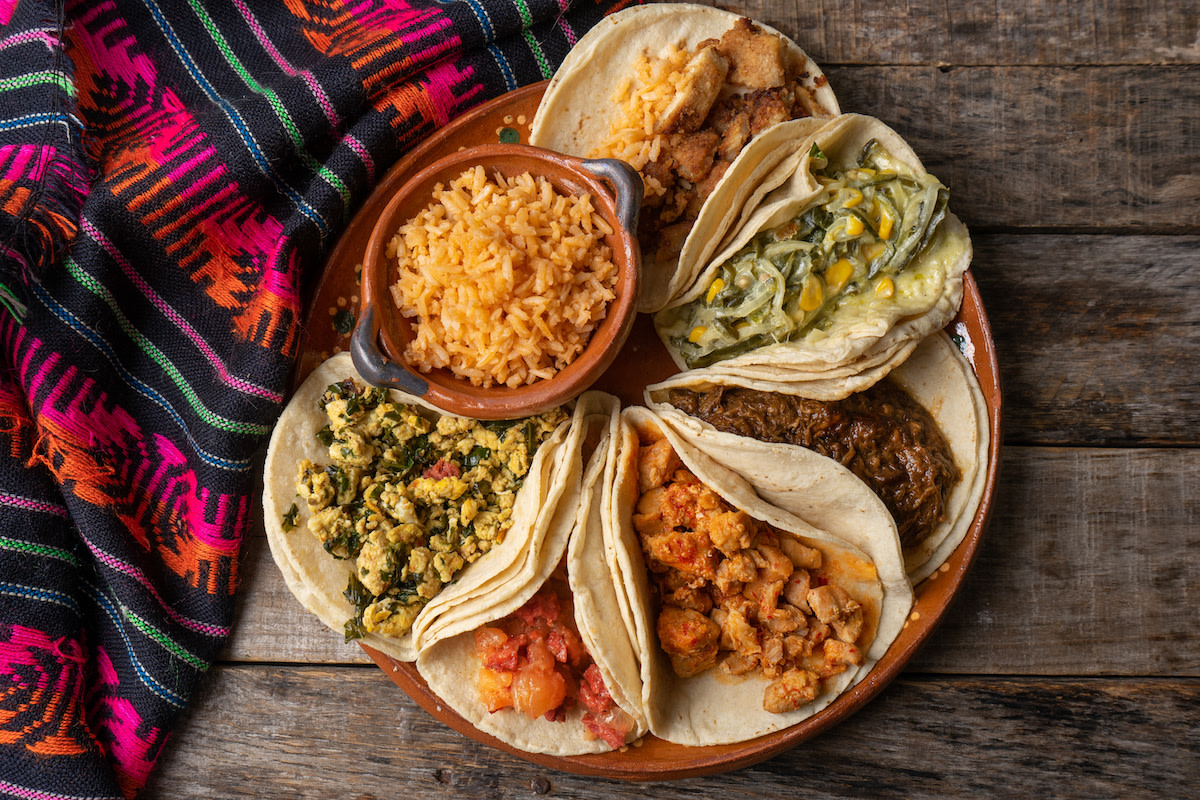If you’re lucky enough to find yourself in Mexico City, Los Angeles, or any number of cities throughout California and Texas, there’s a good chance you’re within throwing distance of the humble champion of street food: the taco.
Topped off with a sprinkle of cilantro, finely chopped white onion, a spritz of a lime wedge, a wedge of avocado, doused in salsa verde or salsa roja, maybe with a few sliced radishes on the side, Mexican street tacos showcase the high art of fast food done right. Swing by a taco stand or taqueria and take it all in.
Learn From the Best
11 Types of Authentic Mexican Tacos
Mexico’s nine regions—Baja California, the Pacific Coastal Lowlands, the Mexican Plateau, the Sierra Madre Oriental, the Sierra Madre Occidental, the Cordillera Neo-Volcánica, the Gulf Coastal Plain, the Southern Highlands, and the Yucatán Peninsula—are as culinarily diverse as they are culturally diverse. That means that no matter which region you travel to, you’re in for a unique experience when it comes to tacos.
Here are some of the most notable types of tacos with local flair that you’ll find in your travels around the country:
- 1. Tacos de barbacoa: To make these tacos found all over Mexico, meat—typically lamb but sometimes beef or goat—is wrapped in banana or agave leaves and slow-cooked over an open flame or in an underground oven lined with hot coals. The result is a tender shredded beef that melts in your mouth. Barbacoa can be found across Mexico, typically served in taco form with a cup of consommé (a broth made from the meat drippings) on the side.
- 2. Tacos de birria: This goat-based soup hails from the state of Jalisco, though surrounding states like Michoacán, parts of Durango, and Zacatecas also make versions, including one with beef. It’s typically served with tortillas, toppings, and salsas. Birria is often used to sweat out a cruda, or hangover.
- 3. Tacos de cabeza: Cabeza means “head” in Spanish, which is an apropos name for these tacos: They’re made with the meat from the head of a cow and typically served braised or steamed to enhance the meat’s tenderness (cabeza tacos can be quite supple and rich, thanks to the high fat content in the head). It shows up across many regions in Mexico, where customers can choose which section they’d like, from lengua (tongue) to sesos (brain).
- 4. Tacos de carne asada: The state of Sonora in northern Mexico is cattle-raising country, and carne asada tacos (grilled meat) have roots there. The meat—most often the ranchera, or flap steak, from beef short loin—is marinated and grilled over charcoal, then chopped and cooked further on a flattop before it’s served in a flour tortilla.
- 5. Tacos de carnitas: Michoacán lays claim to carnitas, or little meats, usually made from pork shoulder slowly simmered in its own fat, confit-style, until the meat is tender enough to pull apart into little shards. Spoon it into a fresh tortilla and dress it as you’d like it.
- 6. Tacos de chapulín: Chapulines—a.k.a. grasshoppers—are a common snack in Oaxaca and other southern regions of Mexico, where they’re eaten on their own or as a taco filling. These specialty tacos are typically made with crispy, crunchy grasshoppers that have been dried, toasted, and seasoned with garlic, chile peppers, and lime juice.
- 7. Tinga tacos: In the city of Puebla, the popular tinga de pollo taco, or stew taco, is often made from chicken braised in a mild chipotle-tomato sauce seasoned with garlic and a bit of piloncillo, or raw cane sugar. The meat is shredded, served in a tortilla, and topped with chopped onion, cilantro, and lime.
- 8. Tacos de canasta/al vapor/sudados: Common in Mexico City, tacos de canasta or al vapor refer not to a specific filling but rather to the vessel the tacos sit in after having been steamed. Tortillas are filled with anything from tinga (stew) to potatoes, then the whole packet is fried and held in a basket, or canasta, until serving.
- 9. Tacos de pescado: Along Mexico’s Pacific Coast, seafood is a natural choice for taco fillings. The Baja area is famed for its fried fish and/or shrimp tacos, often served with shredded cabbage, pico de gallo, and sour cream. The Mexican state of Nayarit boasts barbecued fish tacos known as pescado zarandeado; the northwestern state of Sinaloa has tacos gobernador, or shrimp with bacon and melted cheese.
- 10. Tacos de cochinita pibil: Cochinita pibil—suckling pig marinated in citrus juice, garlic, and orange-hued achiote paste, then wrapped in banana leaves and roasted in an underground pit—is a regional delicacy in the Yucatán Peninsula. The tender, tangy meat is often served with pickled red onions and fresh tortillas.
- 11. Tacos al pastor/tacos de adobada: There is perhaps no dish more closely linked with Mexico City than tacos al pastor. All across the city, vendors set up spinning trompos—a vertical rotisserie not unlike those used to make gyros—covered in al pastor–marinated meat (usually pork) and anchored on top and bottom with a wedge of pineapple (the juice of the fruit drips down into the meat while it cooks). Taqueros dexterously slice meat off of the spit into a warm corn tortilla and top the taco off with a few slices of caramelized pineapple and a dusting of raw onions and cilantro. The meat is marinated in an adobo sauce featuring chiles and achiote—a bright red spice paste made of ground annatto seeds and vinegar, along with coriander seeds, oregano, cumin, garlic, and other spices—from Mexico’s tropical Yucatán region.
Want to Learn More About Cooking?
Become a better chef with the MasterClass Annual Membership. Gain access to exclusive video lessons taught by culinary masters, including Gabriela Cámara, Chef Thomas Keller, Massimo Bottura, Dominique Ansel, Gordon Ramsay, Alice Waters, and more.
